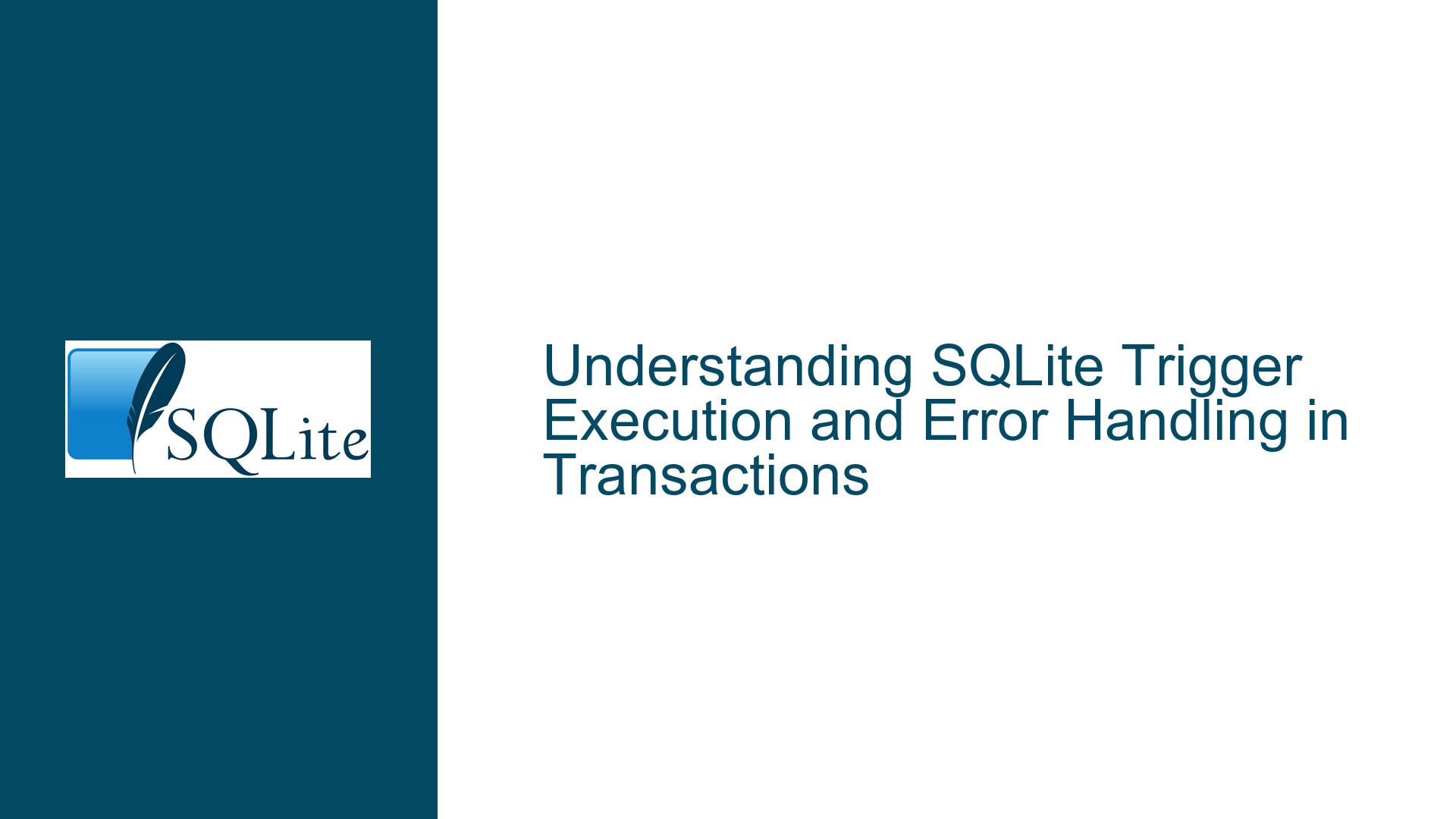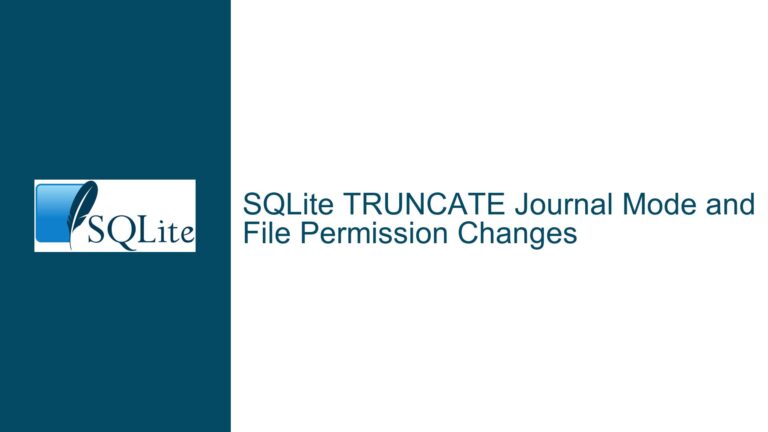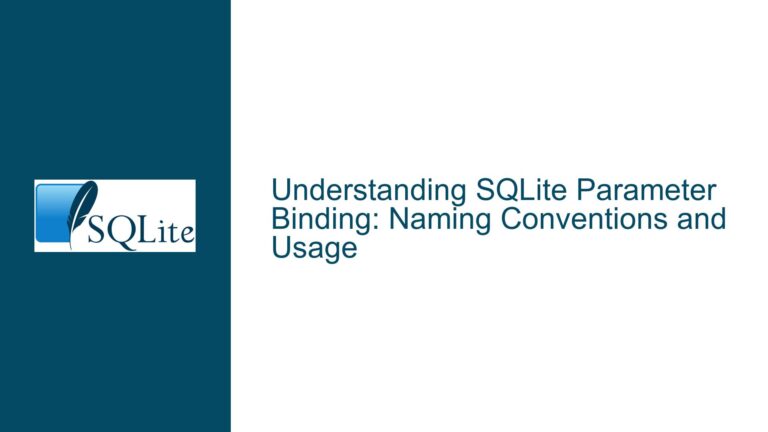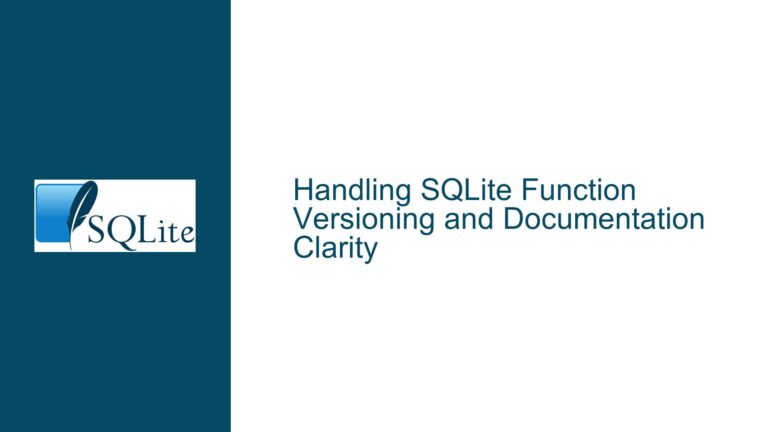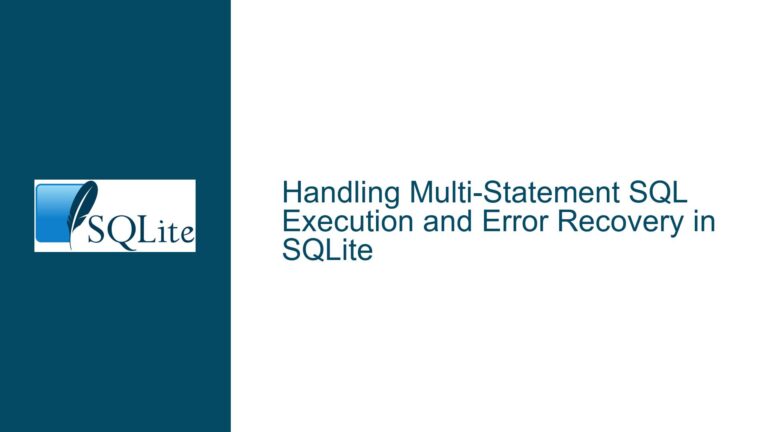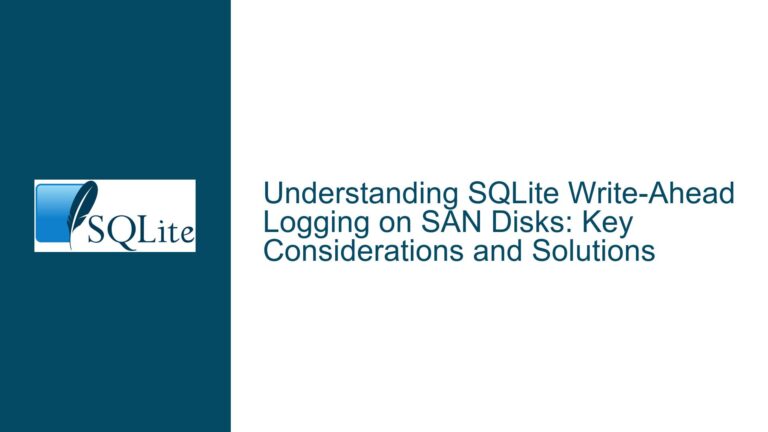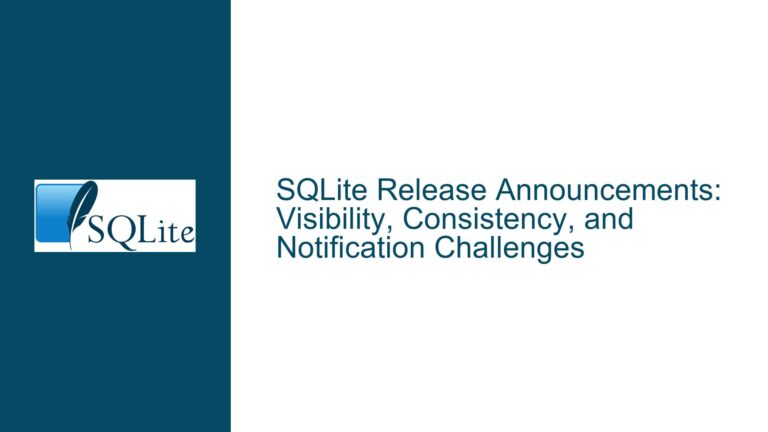SQLite Trigger Execution and Error Handling in Transactions
Issue Overview: Trigger Execution and Error Handling in SQLite
When working with SQLite triggers, one of the most common points of confusion arises from understanding how errors within a trigger affect the execution of the original statement that fired the trigger. Specifically, the behavior of SQLite when an error occurs in the BEGIN-END block of a trigger can be counterintuitive, especially for those who are new to SQLite or database triggers in general.
Consider the following scenario: You have a table named my_table with a simple schema, and you create an AFTER DELETE trigger on this table. The trigger is designed to perform an operation on another table, but this operation is destined to fail because the target table does not exist. When you execute a DELETE statement on my_table, you expect the original DELETE to succeed, and the trigger to fail independently. However, what you observe is that the entire operation, including the original DELETE, is rolled back, and no changes are made to my_table.
This behavior raises several questions: Why does the original DELETE statement not execute when the trigger fails? Is SQLite rolling back the changes by default? Does SQLite parse the trigger’s actions before executing anything? If so, why wasn’t this parsing done when the trigger was created? These questions are central to understanding how SQLite handles trigger execution and error handling within transactions.
Possible Causes: Transaction Rollback and Trigger Compilation
The core issue lies in how SQLite handles transactions and the compilation of triggers. When a DELETE statement is executed on my_table, SQLite begins a transaction implicitly if one is not already active. This transaction encompasses not only the DELETE statement but also any triggers that are fired as a result of the DELETE. If any part of this transaction fails, the entire transaction is rolled back, ensuring data integrity.
In the case of the trigger, the error occurs during the preparation stage of the transaction. SQLite attempts to compile the trigger’s actions into executable code (VDBE code) as part of the transaction. However, because the trigger references a non-existent table (Non_existent_table), the compilation fails. This failure prevents the generation of an execution plan, and as a result, the entire transaction is aborted. Since the transaction is aborted, the original DELETE statement is never executed, and no changes are made to my_table.
This behavior is consistent with SQLite’s transactional model, which ensures that either all operations within a transaction succeed, or none do. This atomicity is crucial for maintaining data integrity, especially in complex operations involving multiple tables and triggers.
Another important aspect to consider is the timing of trigger parsing and compilation. When the trigger is created, SQLite checks for basic syntactic correctness but does not validate the existence of referenced tables or other objects. This validation occurs at runtime when the trigger is executed. This design choice allows for greater flexibility, as it enables the creation of triggers that reference tables or objects that may not exist at the time of creation but will exist at runtime. However, it also means that errors related to missing objects are only detected when the trigger is executed, leading to the observed behavior.
Troubleshooting Steps, Solutions & Fixes: Ensuring Robust Trigger Execution
To address the issue of trigger execution and error handling in SQLite, it is essential to understand the underlying mechanisms and adopt best practices that ensure robust and predictable behavior. The following steps and solutions provide a comprehensive approach to troubleshooting and resolving issues related to trigger execution and error handling.
1. Validate Trigger Logic and Dependencies at Creation Time
One of the first steps in ensuring robust trigger execution is to validate the trigger logic and its dependencies at the time of creation. While SQLite does not perform full validation of referenced objects at trigger creation, you can manually ensure that all tables and objects referenced in the trigger exist and are correctly named. This can be done by running a series of SELECT statements or using the PRAGMA foreign_key_check command to verify the existence of referenced tables and foreign keys.
For example, before creating the trigger, you can execute the following query to check for the existence of Non_existent_table:
SELECT name FROM sqlite_master WHERE type='table' AND name='Non_existent_table';
If the query returns no results, you know that the table does not exist, and you can take corrective action before creating the trigger.
2. Use Explicit Transactions and Error Handling
Another approach to managing trigger execution and error handling is to use explicit transactions and implement error handling mechanisms. By wrapping your DELETE statement and the associated trigger logic in an explicit transaction, you can control the flow of execution and handle errors more gracefully.
For example, you can use the BEGIN TRANSACTION and COMMIT statements to define the scope of the transaction and the ROLLBACK statement to handle errors:
BEGIN TRANSACTION;
DELETE FROM my_table WHERE id=1;
-- Check for errors and rollback if necessary
SELECT CASE WHEN (SELECT changes() = 0) THEN ROLLBACK ELSE COMMIT END;
In this example, the DELETE statement is executed within an explicit transaction. If the DELETE statement or the associated trigger fails, the transaction is rolled back, and no changes are made to my_table. If the DELETE statement succeeds, the transaction is committed, and the changes are applied.
3. Implement Conditional Logic in Triggers
To further enhance the robustness of your triggers, you can implement conditional logic within the trigger itself to handle potential errors or missing objects. For example, you can use the IF EXISTS clause to check for the existence of a table before performing an operation on it:
CREATE TRIGGER R1
AFTER DELETE ON my_table
BEGIN
IF EXISTS (SELECT 1 FROM sqlite_master WHERE type='table' AND name='Non_existent_table') THEN
DELETE FROM Non_existent_table WHERE id=OLD.id;
END IF;
END;
In this example, the trigger checks for the existence of Non_existent_table before attempting to delete a row from it. If the table does not exist, the DELETE statement is skipped, and the trigger completes successfully without causing an error.
4. Monitor and Log Trigger Execution
Monitoring and logging trigger execution can provide valuable insights into the behavior of your triggers and help identify potential issues before they become critical. You can implement logging within your triggers by inserting log entries into a dedicated log table:
CREATE TABLE trigger_log (
id INTEGER PRIMARY KEY AUTOINCREMENT,
trigger_name TEXT,
execution_time DATETIME,
message TEXT
);
CREATE TRIGGER R1
AFTER DELETE ON my_table
BEGIN
INSERT INTO trigger_log (trigger_name, execution_time, message)
VALUES ('R1', datetime('now'), 'Attempting to delete from Non_existent_table');
DELETE FROM Non_existent_table WHERE id=OLD.id;
INSERT INTO trigger_log (trigger_name, execution_time, message)
VALUES ('R1', datetime('now'), 'Delete operation completed');
END;
In this example, the trigger logs its execution by inserting entries into the trigger_log table. If the DELETE statement fails, the log entry will indicate the point of failure, allowing you to diagnose and resolve the issue.
5. Review and Optimize Trigger Logic
Finally, it is essential to regularly review and optimize your trigger logic to ensure that it aligns with your application’s requirements and performs efficiently. This includes evaluating the necessity of each trigger, optimizing the SQL statements within the trigger, and ensuring that the trigger logic is consistent with the overall database schema and application logic.
For example, if you find that a trigger is frequently causing errors due to missing objects, you may need to reconsider the design of your database schema or the logic of the trigger. In some cases, it may be more appropriate to handle certain operations at the application level rather than within a trigger.
Conclusion
Understanding how SQLite handles trigger execution and error handling is crucial for developing robust and reliable database applications. By validating trigger logic and dependencies, using explicit transactions and error handling, implementing conditional logic, monitoring and logging trigger execution, and regularly reviewing and optimizing trigger logic, you can ensure that your triggers perform as expected and maintain the integrity of your data.
SQLite’s transactional model and trigger execution behavior are designed to provide atomicity and consistency, ensuring that either all operations within a transaction succeed, or none do. While this behavior can be initially confusing, it is a powerful feature that, when understood and used correctly, can greatly enhance the reliability and robustness of your database applications.
